
As we continue working from home—isolated from loved ones, juggling work/life balance and trying to make sense of this seemingly never-ending pandemic—stress levels are at an all-time high. So it’s more important than ever to ensure the well-being of your workforce.
The harmful side effects of long-term stress can lead to increased absenteeism, poor work quality and decreased morale. Taking the time to show you care about your employees’ mental health, by developing activities and resources that help alleviate stress, can create a sustainable, positive workplace.
Without effective mental health resources in place, it could cost your organization its best employees. Uncover 7 Tips to Keep Your Nonprofit Employees Mentally Sound to help foster an engaged workforce during these uncertain times.
Would you like access to more HR-specific articles, templates and checklists? Sign up for a FREE 60-Day UST HR Workplace Trial today! (Use priority code “2020HR-Content” to expedite your request).
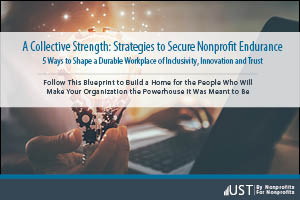
UST releases a new eBook, focused on positive brand perception in today’s increasingly competitive job market.
Founded by nonprofits, for nonprofits, UST publishes an eBook that discusses the importance of ensuring you have a solid brand reputation and why. This insightful eBook uncovers strategies that nonprofit employers can utilize to attract employees that fit their organization’s culture, mission, and values—and keep them.
Available now for download, UST’s eBook explores 5 key strategies that can help strengthen your organization’s culture through inclusivity, innovation and trust.
You’ll also discover:
Don’t miss your opportunity to download your complimentary copy of “A Collective Strength: Strategies to Secure Nonprofit Endurance” to discover how to attract better talent and promote a diverse and inclusive workplace.

Question: Some of our employees have said they don’t feel safe returning to work. Can we just permanently replace them?
Answer: We recommend extreme caution when deciding to replace an employee who refuses to work because of concerns about COVID-19. Generally, employees do not have a right to refuse to work based only on a generalized fear of becoming ill if their fear is not based on objective evidence of possible exposure. However, under the current circumstances, where COVID-19 continues to be a threat across the country, we think it would be difficult to show that employees have no reason to fear coming in to work, particularly but not exclusively in a location with a shelter-in-place rule. Returning employees may also have certain rights under state and federal law. Here are few things to keep in mind:
Check state and local law to see if additional protections may apply.
Instead of replacing employees who express fear at this time, we recommend that you consider methods to encourage employees to come to work and to help put their minds at ease. Consider emphasizing all of the safety methods you have put in place (such as scheduled handwashing, frequent disinfection of surfaces, social distancing rules, reduced customer capacity, staggered shifts, or more extreme measures if warranted by your industry). We recommend relying on the Centers for Disease Control and Prevention (CDC) and local health department guidance for establishing safe working conditions at this time. You might also consider offering premium pay (a.k.a. hazard pay) or additional paid time off for use in the future to employees who must come to work.
Q&A provided by ThinkHR, powering the UST HR Workplace for nonprofit HR teams. Have HR questions? Sign your nonprofit up for a free 60-day trial today.
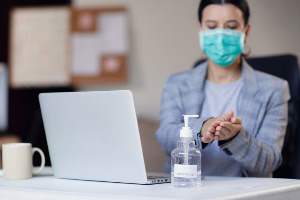
As nonprofit organizations prepare to return to business as usual, there are quite a few new safety protocols being put in place to ensure that employees return to a safe work environment. The Center for Disease Control – CDC continues to release updated guidelines for employers to help prevent and slow the spread of COVID-19 in the workplace. When making decisions around business operations, two main components should be factored in: (1) the level of disease transmission in your community and (2) how prepared your business is to protect both your employees and customers.
Employers are encouraged to coordinate with their state and local health officials to acquire timely and accurate information to provide updates to employees as needed. If your nonprofit’s business operations were put on hold, or are gearing up for workforce re-entry, this is an opportunity to update your COVID-19 preparedness, response and control plans.
When making the appropriate updates to your organization’s COVID-19 plans, the following items should be included:
Be sure to take the time to communicate with your employees of any changes and ask for their input—their questions and concerns can ensure all your bases are covered when creating the COVID-19 plan for your organization. Educating our employees on the severity of taking the necessary precautions to keep themselves and others safe is vital. To protect themselves while at work and at home, new policies and procedures related to illness, cleaning and disinfecting should be followed.
To ensure a safe workplace environment, employers should advise their employees of the following:
While there is much more to learn about the severity and characteristics of this virus, as a nonprofit employer, you can do your part to follow important guidelines to create a safe and healthy working environment for your dedicated employees.
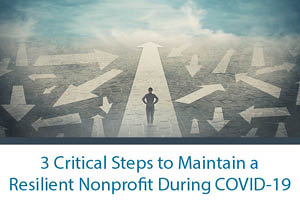
Are you still trying to figure out how to navigate the uncertainty of COVID-19 and its impact on your nonprofit and its employees? When you download UST’s new employer guide, 3 Critical Steps to Maintain a Resilient Nonprofit During COVID-19, you’ll discover helpful tips on maintaining your nonprofits operations during the current pandemic and beyond.
This short employer guide shares valuable insights and key strategies for securing your brand during times of crisis, including:
This guide will not only enable you to stay on top of strategy development, but also equip you with the tools you need to help your employees feel safe. Download your FREE copy today!
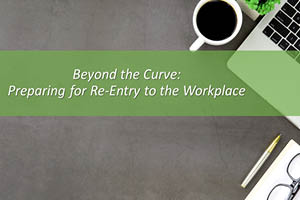
Nonprofit employers have faced unimaginable challenges in the wake of the COVID-19 pandemic. Now, as states start permitting businesses to reopen, nonprofits across the country are trying to figure out what that looks like for them, their employees and the communities they serve.
This informative webinar recording provides helpful tips for preparing to welcome employees back to the office while maintaining compliance with state and federal regulations related to the Coronavirus. Watch now to discover:
For additional COVID-19 employer resources and FAQs, please visit our COVID-19 Resource Center today!
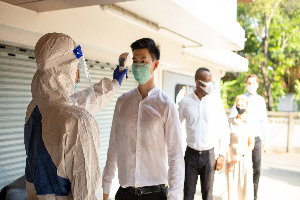
Question: Can we screen employees returning to work for COVID-19?
Answer: Yes. Generally, inquiries about an employee’s health or a medical exam (like a temperature check) would not be allowed, but the Equal Employment Opportunity Commission (EEOC) has stated that screening employees for symptoms of COVID-19 is allowed since it is a direct threat to others in the workplace. Because of that, you may inquire about symptoms related to the virus, require self-reporting by employees, and take employees’ temperatures.
Known symptoms of COVID-19 include fever, cough, chills, shortness of breath or difficulty breathing, muscle pain, headache, sore throat, and sudden loss of taste or smell. As the medical community learns more about COVID-19, additional symptoms could be added to this list. Employers can check this page for currently recognized symptoms.
If you decide to do screenings, make sure you screen all employees; otherwise you may find yourself in the middle of a discrimination claim. And remember that all information about employees’ health — including a lack of symptoms or temperature — must be kept confidential.
Q&A provided by ThinkHR, powering the UST HR Workplace for nonprofit HR teams. Have HR questions? Sign your nonprofit up for a free 60-day trial today.

While we continue to adjust to this new “normal” of working remotely—with little to no face-to-face interaction—the COVID-19 pandemic has taken a major toll on nonprofit employees and their mental health.
This informative webinar provides helpful tips on how nonprofit leaders can help keep employees productive and engaged in day-to-day work activities. Watch now to learn key strategies that include:
For more access to nonprofit specific how-to guides, checklists and resources? Sign up for UST’s monthly eNews today!

Question: What’s the difference between a furlough and a layoff?
Answer: First, you should note that the language used when sending employees home for a period of time is less important than communicating your actual intent. Since temporary layoffs and furloughs are only used regularly in certain industries (usually seasonal), you should not assume that employees will know what they mean. Be sure to communicate your plans for the future, even if they feel quite uncertain or are only short-term.
Furlough
A furlough continues employment but reduces scheduled hours or requires a period of unpaid leave. The thought process is that having all employees incur a bit of hardship is better than some losing their jobs completely. For example, a company may reduce hours to 20 per week for a period of time as a cost-saving measure, or they may place everyone on a two-week unpaid leave. This is typically not considered termination; however, you may still need to provide certain notices to employees about the change in the relationship, and they would likely still be eligible for unemployment.
If the entire company won’t be furloughed, but only certain employees, it is important to be able to show that staff selection is not being done for a discriminatory reason. You’ll want to document the nondiscriminatory business reasons that support the decision to furlough certain employees and not others, such as those that perform essential services.
Layoff
A layoff involves terminating employment during a period when no work is available. This may be temporary or permanent. If you close down completely, but you intend to reopen in the relatively near future or have an expected reopening date — at which time you will rehire an employee, or all employees — this would be considered a temporary layoff. Temporary layoffs are appropriate for relatively short-term slowdowns or closures. A layoff is generally considered permanent if there are no plans to rehire the employee or employees because the slowdown or closure is expected to be lengthy or permanent.
Pay for exempt employees (those not entitled to overtime)
Exempt employees do not have to be paid if they do no work at all for an entire workweek. However, if work is not available for a partial week for an exempt employee, they must be paid their full salary for that week, regardless of the fact that they have done less work. If the point is to save money (and it usually is), it’s best to ensure that the layoff covers the company’s established seven-day workweek for exempt employees. Make it very clear to exempt employees that they should do absolutely no work during any week you’re shut down. If exempt employees do any work during that time, they will need to be paid their normal weekly salary.
Pay for nonexempt employees (those entitled to overtime)
Nonexempt employees only need to be paid for actual hours worked, so single day or partial-week furloughs can be applied to them without worrying about pay implications. We recommend that you engage in open communication with the affected employees before and during the furlough or temporary layoff period.
Q&A provided by ThinkHR, powering the UST HR Workplace for nonprofit HR teams. Have HR questions? Sign your nonprofit up for a free 30-day trial today.
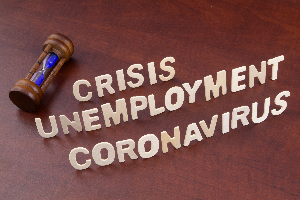
Nonprofits are facing unprecedented challenges navigating COVID-19 and its impact on day-to-day operations. Our recent webinar was designed to provide some valuable insight into the latest unemployment legislation and its impact on your organization and its employees.
This informative webinar recording discusses how COVID-19 is impacting nonprofits nationwide, what alternatives there are to layoffs and/or workforce reductions and more. Watch now to discover:
For additional COVID-19 employer resources and FAQs, please visit our COVID-19 Resource Center today!

UST maintains a secure site. This means that information we obtain from you in the process of enrolling is protected and cannot be viewed by others. Information about your agency is provided to our various service providers once you enroll in UST for the purpose of providing you with the best possible service. Your information will never be sold or rented to other entities that are not affiliated with UST. Agencies that are actively enrolled in UST are listed for review by other agencies, UST’s sponsors and potential participants, but no information specific to your agency can be reviewed by anyone not affiliated with UST and not otherwise engaged in providing services to you except as required by law or valid legal process.
Your use of this site and the provision of basic information constitute your consent for UST to use the information supplied.
UST may collect generic information about overall website traffic, and use other analytical information and tools to help us improve our website and provide the best possible information and service. As you browse UST’s website, cookies may also be placed on your computer so that we can better understand what information our visitors are most interested in, and to help direct you to other relevant information. These cookies do not collect personal information such as your name, email, postal address or phone number. To opt out of some of these cookies, click here. If you are a Twitter user, and prefer not to have Twitter ad content tailored to you, learn more here.
Further, our website may contain links to other sites. Anytime you connect to another website, their respective privacy policy will apply and UST is not responsible for the privacy practices of others.
This Privacy Policy and the Terms of Use for our site is subject to change.
UST maintains a secure site. This means that information we obtain from you in the process of enrolling is protected and cannot be viewed by others. Information about your agency is provided to our various service providers once you enroll in UST for the purpose of providing you with the best possible service. Your information will never be sold or rented to other entities that are not affiliated with UST. Agencies that are actively enrolled in UST are listed for review by other agencies, UST’s sponsors and potential participants, but no information specific to your agency can be reviewed by anyone not affiliated with UST and not otherwise engaged in providing services to you except as required by law or valid legal process.
Your use of this site and the provision of basic information constitute your consent for UST to use the information supplied.
UST may collect generic information about overall website traffic, and use other analytical information and tools to help us improve our website and provide the best possible information and service. As you browse UST’s website, cookies may also be placed on your computer so that we can better understand what information our visitors are most interested in, and to help direct you to other relevant information. These cookies do not collect personal information such as your name, email, postal address or phone number. To opt out of some of these cookies, click here. If you are a Twitter user, and prefer not to have Twitter ad content tailored to you, learn more here.
Further, our website may contain links to other sites. Anytime you connect to another website, their respective privacy policy will apply and UST is not responsible for the privacy practices of others.
This Privacy Policy and the Terms of Use for our site is subject to change.